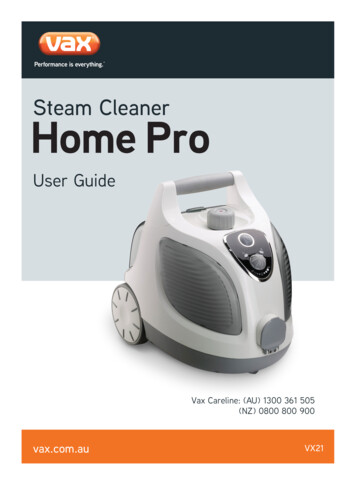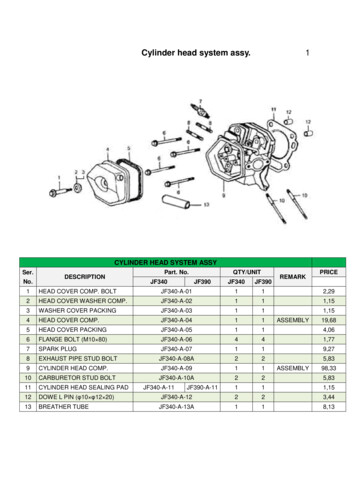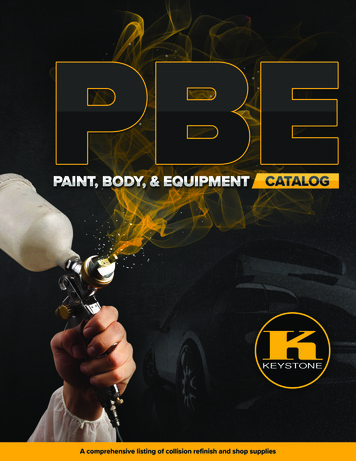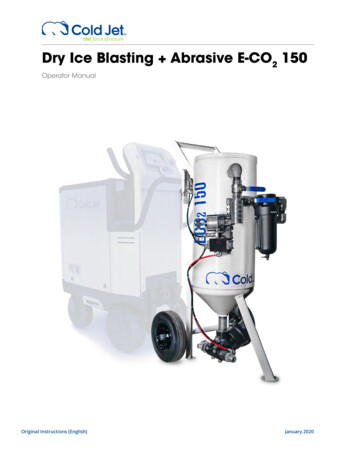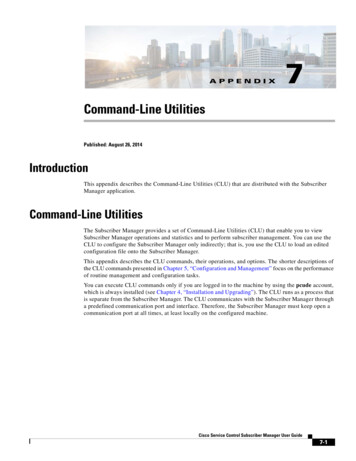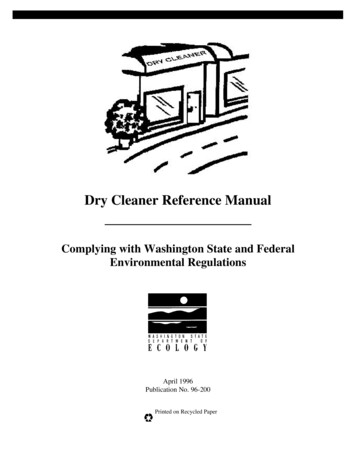
Transcription
Dry Cleaner Reference ManualComplying with Washington State and FederalEnvironmental RegulationsApril 1996Publication No. 96-200Printed on Recycled Paper
For additional copies of this manual, contact:Department of EcologyPublications Distribution CenterPO Box 47600Olympia, WA 98504-7600Telephone: (360) 407-7472The Department of Ecology is an equal opportunity agency and does not discriminate on the basis ofrace, creed, color, disability, age, religion, national origin, sex, marital status, disabled veteran's status,Vietnam Era veteran's status or sexual orientation.For more information or if you have special accommodation needs, please contact the Air QualityProgram at (360) 407-6830.
Table of ContentsINTRODUCTION.1ENVIRONMENTAL HAZARDS.2REQUIRED OPERATING PRACTICES.3General Requirements .3PERC Requirements .3DANGEROUS WASTES AND MATERIALS .5Identify Your Dangerous Wastes.5Count Your Dangerous Wastes.6Identify Your Generator Status.6Small Quantity Generators .6Regulated Generators .7Obtain a Generator Identification Number .8Store Dangerous Wastes and Materials Properly .8Track Accumulation of Dangerous Wastes and Materials . 10Transport and Dispose of Dangerous Wastes Properly . 10Report Dangerous Wastes. 11Keep Proper Records of Dangerous Waste Activities. 11SEPARATOR WATER.12TRASH, GARBAGE, AND SOLID WASTES .14Identify Non-Dangerous Waste Materials. 14Recycle If Possible. 14POLLUTION PREVENTION .15i
SPILL PREVENTION AND RESPONSE .17Control Spills Immediately .17Dispose of Spill Cleanup Materials Properly.18Prevent Spills.18Emergency Planning .19RECORD KEEPING AND REPORTING REQUIREMENTS .20Files you should keep for as long as you are in business.20Files you should keep for at least five years.20APPENDICES.23WHO TO CALLWho to Call for Compliance, Pollution Prevention, and Technical Assistance. 25Services and Vendors for Dry Cleaners . 29Department of Ecology Regional Offices . 33IDENTIFYING YOUR DANGEROUS WASTES . 34RECOMMENDED MAINTENANCE SCHEDULE FOR DRY CLEANERS. 35DRY CLEANER DANGEROUS WASTE ANNUAL REPORTING EXAMPLESGeneration and Management Form -- Example for PERC Filter. 38Generation and Management Form -- Example for PERC Separator Water. 40Generation and Management Form -- Example for PERC Muck, Still Bottoms, andFilter Coatings. 42SUGGESTED RECORD KEEPING FORMSPCE Purchase Log . 44Perchloroethylene Dry Cleaner Equipment Inspection and Repair Log. 45Refrigerated Condenser Weekly Temperature Log . 46Carbon Adsorber Weekly PERC Concentration Log. 47Corrective Action Form. 48INDEX .49ii
IntroductionThe purpose of this manual is to help dry cleaners understand and complywith state and federal environmental regulations. It is intended to be used as adesktop reference manual. It summarizes current requirements andrecommendations for dry cleaners on dangerous waste management anddisposal, sewer discharge, solid waste management and disposal, spillprevention and control, and general operating practices.This manual does not include information on local regulations. Localauthorities such as solid waste districts, county health departments, airpollution control agencies, and sewage treatment districts may have additionalenvironmental requirements. A list of agencies to contact for technicalassistance on requirements in your area is included. For more detailedinformation on topics included in this manual, see the actual regulations forair, dangerous waste and waste water. These are available from theDepartment of Ecology, PO Box 47600, Olympia, WA 98504-7600.1
Environmental HazardsThe main source of pollution from a dry cleaner is the solvent used in thecleaning process. In Washington, about 800 dry cleaners useperchloroethylene (PERC); about 50 use petroleum solvents; and a smallnumber use freon-type solvents. Altogether, dry cleaning businesses inWashington release about 110,000 gallons per year of PERC and 50,000gallons per year of petroleum solvent into the air, water, and soil. Thesepollutants can affect human health and safety and the environment.v PERC is a known cancer-causing chemical in animals and may contributeto cancers in humans. In the workplace, air concentrations of PERCshould not exceed 25 parts per million. Long-term outdoor airconcentrations of PERC as low as one-tenth part per billion are a possiblepublic health problem. In addition, spills and leaks can lead to PERCcontamination of soil, surface water, and ground water.v Petroleum solvents used in dry cleaning are "volatile organic compounds."They are flammable. The extent of their flammability varies with eachcommercial blend. When released to the environment in liquid form,petroleum solvents can contaminate soil, surface water, and ground water.When released into the air, they react with sunlight and contribute to smog.v Freon-type solvents break down the protective ozone layer in the earth'supper atmosphere. Freon production is being phased out internationally.Operating practices described in this manual for PERC dry cleaners arealso applicable to dry cleaners using freon.2
Required Operating PracticesGeneral RequirementsThe following are requirements for all dry cleaners:v File a Notice of Construction with your local air pollution control agencybefore adding or replacing dry cleaning equipment. Call your local airpollution control agency for more information about the Notice ofConstruction (see page 25 for listing).v Determine whether you are a regulated dangerous waste generator or asmall quantity dangerous waste generator (see page 6, Identify YourGenerator Status). Follow the requirements for handling dangerous wastebeginning on page 5.v Keep proper records and file required reports. See page 20, RecordKeeping and Reporting Requirements.v Keep Material Safety Data Sheets (MSD sheets) on-site and readilyaccessible to employees and regulator inspectors for PERC, othersolvents, detergents, and all other chemical supplies. Be sure to get theseMSD sheets from your supplier.PERC RequirementsThe following are requirements for all PERC dry cleaners. They are stronglyrecommended (where applicable) for dry cleaners using other solvents:Equipment Installation, Use, Maintenance andRepairv Transfer equipment: Do not install transfer equipment. You maycontinue to use transfer equipment installed before 9/21/93.v Leaks: Check equipment weekly for leaks, and keep records of any leaksand repairs. Order repair parts as soon as possible and install them withinfive days of receipt. Vapor leaks around the door of the dryer cansometimes be detected by running a finger or squirting a soapy solutionalong the door edge. However, an electronic halogen leak detector ismore reliable.If you repair equipment yourself, refer to the vendor, owner's manual, ormanufacturer.3
v Design and operation specifications: Keep design specifications andoperating manuals on-site for all equipment and emissions control devices.v Operation and maintenance: Operate and maintain equipment accordingto manufacturer's specifications and recommendations. At a minimum,follow the Recommended Maintenance Schedule for Dry Cleaners on page35 as it applies to your equipment. For a detailed maintenance guide, callthe U.S. Environmental Protection Agency (EPA) library, (919) 541-5514and ask for EPA document 4531R-94-073, General RecommendedOperating and Maintenance Practices for Dry Cleaning Equipment.Record KeepingSee page 20, Record Keeping and Reporting Requirements.PERC StorageStore all PERC and waste containing PERC in sealed containers. See page 8,Store Dangerous Wastes and Materials Properly.PERC Recoveryv For a refrigerated condenser on the dryer vent: Be sure thetemperature in the outlet of the refrigerated condenser is not above 45degrees Fahrenheit.v For a refrigerated condenser on the vent from the washer in transferequipment: Be sure the difference between the inlet and outlettemperatures of the refrigerated condenser is greater than 20 degreesFahrenheit.v For an activated carbon adsorber on the dryer vent: Measure thePERC concentration in the outlet from the adsorber with a colorimetricdetector tube or hand-held detector when you do your weekly leakinspections and while the dryer is in use. It must be less than 100 parts permillion. If the PERC concentration is higher than that, the carbon in theadsorber needs to be regenerated or replaced. The activated carbon is adangerous waste when you decide to dispose of it. (See page 10, Transportand Dispose of Dangerous Waste Properly.)4
Dangerous Wastes and MaterialsDangerous wastes and materials may not be put in the garbage or dischargedinto the sewer. Only rest room or hand washing waste water and launderingwaste water that has not been contaminated with dry cleaning solvent may bedisposed of in a municipal sewer system. Only restroom or hand washingwater may be disposed of in a septic system.Handle dangerous wastes in a manner that prevents leaks, spills andexplosions, as described in this chapter. Develop and follow a writtenoperating plan. Your operating plan should include an inspection schedule forall dangerous waste storage areas, containers and tanks; and procedures foremergencies, safety and monitoring of equipment. See page 19, EmergencyPlanning, for more information.Old supplies such as spotting chemicals and laundry materials that you nolonger use should be disposed of. An inspector may determine that they are"accumulated" dangerous wastes, and you may be in violation of disposalrequirements (see page 10) unless you can show clearly when, where and howyou plan to use them. Check the labels and MSD sheets to see if they aredangerous materials. If so, dispose of them as prescribed in this section. Ifthey are not dangerous materials, they may be disposed of in the trash.Identify Your Dangerous WastesAny waste that is toxic, corrosive, flammable or explosive is a dangerouswaste, as is anything contaminated with PERC.Common dangerous wastes present at dry cleaning facilities are: Filters MuckFilter coatings Separator water*Still bottoms Solvent-contaminated lintDiscarded solvent PERC sludgeSome spotting solutions Cleanup materials fromwhen discardedsolvent spillsActivated carbon that will not be regenerated*Separator water is a dangerous waste and may not be disposed of in sewer systems orseptic tanks. See Page 12, Separator Water, for more information.5
Count Your Dangerous WastesAll dry cleaners must keep track of their dangerous wastes in pounds toward amonthly total. (See common dangerous wastes in Section 1 above.) If youhave questions about how to count your dangerous wastes, see page 25 forwho to contact in your area.PERC dry cleaners: Include in your dangerous waste total: (1) the amount ofPERC in the equipment reservoir at the end of each month; and (2) the amountof PERC added during the month, unless you meet all of the followingconditions:v The PERC still and filters are completely enclosed and connected directlyto the dry cleaning machine. This means the PERC is not exposed to theenvironment when it is transferred between the dry cleaning reservoir,machine, still, or filters.v Any air leaving the equipment during the drying cycle passes through asolvent capture device such as a condenser or activated carbon unit.v All dangerous wastes, including separator water, are disposed of inaccordance with dangerous waste regulations (see page 10, Transport andDispose of Dangerous Waste Properly).Identify Your Generator StatusAll dry cleaners need to know whether they are a Regulated Generator or aSmall Quantity Generator in order to know what requirements apply to them.Regulated Generators must meet more extensive and expensive requirementsthan Small Quantity Generators. For technical assistance on managing yourdangerous wastes, contact your local dangerous waste agency (page 25) orDepartment of Ecology regional office (page 33).Small Quantity GeneratorsA dry cleaner is a Small Quantity Generator if:v you always generate less than 220 pounds of dangerous waste per month;andv you always dispose of your dangerous waste before it reaches 2,200pounds on-site at any one time.6
If a dry cleaner remains a Small Quantity Generator, it is easier and cheaper tomanage wastes. The following requirements apply to Small QuantityGenerators:v Small Quantity Generators are only required to ensure that dangerouswastes and materials are transported to an appropriate disposal site, andmay transport their dangerous wastes themselves.Some county solid waste districts have drop-off sites for Small QuantityGenerators. For more information on this, call your local dangerouswaste agency (see page 25 for listing).Whether you transport your dangerous waste yourself or hire a registeredtransporter, you must be sure that dangerous wastes are handled in one of twoways:v They are treated, stored or disposed of at a permitted dangerous wastefacility; orv They are legitimately recycled or reclaimed by the facility to which theyare delivered.Small quantity generators can also take their waste to:v Any permitted dangerous waste fixed facility or local small quantitygenerator collection event that will accept it; orv Any landfill whose operator and health district allow that waste.Regulated GeneratorsA dry cleaner is a Regulated Generator if:v you have ever generated more than 220 pounds of dangerous waste permonth; orv you have ever accumulated 2,200 pounds or more of dangerous waste.Regulated Generators must meet more extensive and expensive requirementsthan Small Quantity Generators. A Regulated Generator can return to SmallQuantity Generator status under the following conditions:7
v If you became a Regulated Generator because you generated 220 poundsor more of dangerous waste in a month, you will be a Small QuantityGenerator again when you reduce your dangerous waste generation tobelow 220 pounds per month.v If you became a Regulated Generator because you accumulated 2,200pounds of dangerous waste, you will be a Small Quantity Generator againwhen there is no dangerous waste left at your facility.The following is required of RegulatedGenerators only. However, Small Quantity Generators(SQGs) should note the areas marked to the side pointing outthose procedures which are recommended for SQGs.Obtain a Generator Identification NumberRegulated Generators must obtain a generator identification number or RCRAnumber. A generator identification number is used on Department of Ecologyreport forms.For information about getting a generator identification number (also known asa RCRA number), contact the Department of Ecology, (360) 407-6737.Store Dangerous Wastes and MaterialsProperlyFor Regulated Generators, there are time limits on dangerous wasteaccumulation. See page 10, Track Accumulation of Dangerous Wastes andMaterials.Regulated Generators must meet the following requirements for storingdangerous wastes and materials:Use Proper Containers.v Accumulate and store your dangerous wastes and materials in sturdy, leakproof, sealed and properly labeled containers. Acceptable containersinclude those made of polyethylene plastic, but only short term in the caseof PERC or waste containing PERC (see next paragraph). Uncoated metalcontainers are not acceptable for PERC and PERC-containing wastes.v Store all PERC and waste containing PERC in sealed containers. Plastic orcoated metal containers are acceptable for short term storage. However,PERC will deteriorate common plastics and cause exposed steel to rust. Ifyou use plastic or metal buckets to store waste containing PERC, examinethem frequently for deterioration and potential leaks. Otherwise, contact8Recommendedfor SQG
an appropriate supplier for PERC resistant containers (see page 29 for alisting of vendors). Examples of wastes containing PERC are: still bottomsspent filtersany activated carbon that will not be regeneratedmuckseparator waterv If filters are drained outside the filter housing, drain them into containersthat are then sealed.v Keep containers closed except when adding or removing materials.v Keep a tight lid on your water separator. Run a vent line from it througha water trap to prevent evaporation of solvent vapors into the air.v If you are collecting your separator water by letting your separator tankoverflow drip into a bucket, the bucket must be kept covered to minimizeevaporation. (A small hole in the cover to allow entry of the hose fromthe separator water tank is acceptable.) The bucket must not be allowedto overflow. Check it frequently.v Store reactive and ignitable wastes and materials according to the UniformFire Code. Call your local fire marshal for information on theserequirements.Recommendedfor SQGLabel Containers Properly.All waste containers must be clearly labeled with the following information:v The words "Dangerous Waste."v The waste's major risk. For example, waste containing PERC or Valcleneshould be labeled "Toxic." Wastes containing petroleum solvent shouldbe labeled "Ignitable."v The date you started to fill the container with dangerous waste.Recommendedfor SQGStore Waste and Materials in Proper Locations.v Store dangerous wastes and materials indoors if possible. Do not store inalleys or parking lots.v Establish and clearly mark an accumulation area.9
If constructed after September 30, 1986, the accumulation area must havea containment system capable of holding spills and leaks. Examples ofacceptable containment systems include: a barrel to hold the main storage drum;a concrete curb around the dangerous waste drum; ora commercially available spill tank.The containment system must be able to hold at least 10 percent of themaximum amount of dangerous waste you are capable of accumulating; orthe volume of the largest container you use to hold dangerous waste,whichever is greater.Track Accumulation of Dangerous Wastesand MaterialsIf you accumulate less than 2,200 pounds of dangerous waste before disposingof it, you can keep the dangerous waste on site for up to 180 days. If youaccumulate 2,200 pounds or more of dangerous waste, it must be disposed ofin 90 days or less. The 90 days or 180 days begin when you first start to storedangerous waste after having shipped out the previous batch.Transport and Dispose of DangerousWastes ProperlyDo not discharge separator water or any other dangerous waste down thesewer or into septic systems, into any other drain, or onto the ground. Onlyrest room or hand washing waste water and laundering waste water that hasnot been contaminated with dry cleaning solvent may be disposed of in amunicipal sewer system. Only restroom or hand washing waste water may bedisposed of in a septic system. See page 12, Separator Water, for moreinformation.Regulated Generators must meet the following requirements for transportingand/or disposing of dangerous wastes:Transporting Dangerous Wastesv Regulated Generators must hire a transporter with a RCRA identificationnumber. See page 29 for a listing of transporters.v Any dangerous waste being tranported must be: 10treated, stored or disposed of at a permitted dangerous waste facility;orRecommendedfor SQG
legitimately recycled or reclaimed by the facility to which it isdelivered.v Regulated Generators must prepare a Uniform Dangerous Waste ManifestForm (manifest form) before having their wastes transported (see theinstructions and sample forms beginning on page 36). Waste haulers forRegulated Generators must use a manifest and not just a bill of lading orreceipt. The manifest form must identify what the wastes are, who istransporting them and where they are going. The manifest form goes with the wastes until they reach their finaldestination. It is then returned to the dry cleaner. The copy of themanifest form that is returned to you from the disposal facility is yourdocumentation that your wastes were disposed of properly, and shouldbe kept in your records (see page 20, Record Keeping and ReportingRequirements).v Dangerous wastes must be transported according to U.S. Department ofTransportation regulations. For more information on this, call your localdangerous waste agency listed on page 25.Report Dangerous WastesRegulated Generators must submit a dangerous waste report by March 1 forthe previous calendar year, even if you have not generated dangerous wasteduring that year. Report on the following Ecology forms: the General SiteInformation Form, the Generation and Management Form; and the Off-siteIdentification Information Form. Examples of the Generation andManagement Form are shown beginning on page 38. An example is shownfor each of the three most common types of dangerous waste.For assistance on filling out and submitting reporting forms, contact yourEcology regional office (see page 33 for a listing).Keep Proper Records of Dangerous WasteActivitiesSee page 20, Record Keeping and Reporting Requirements.11
Separator WaterSeparator water is a dangerous waste. Do not discharge separator water orany other dangerous waste down the sewer, into any other drain or onto theground. Only rest room or hand washing waste water and laundering wastewater that has not been contaminated with dry cleaning solvent may bedisposed of in a municipal sewer system. Only restroom or hand washingwaste water may be disposed of in a septic system.Two options are available to you regarding separator water:Option 1:v To store and dispose of separator water, follow the procedures describedbeginning on page 5, Dangerous Wastes and Materials.v In addition, if you are collecting your separator water by letting yourseparator tank overflow drip into a bucket, the bucket must be keptcovered to minimize evaporation. (A small hole in the cover to allow entryof the hose from the separator water tank is acceptable.) The bucket mustnot be allowed to overflow. Check it frequently.Option 2:v You may evaporate your separator water IF it has first been treated toreduce its PERC concentration to below 0.7 parts per million. A possibleway to do this is: Be sure you let the separator water stand long enough so that it is clear(in other words, you can see through it and it is not in any way"milky"); and Be sure that the separator water has been separated from any PERCthat may be in the bottom of the container in which you have beencollecting the separator water; and Pass the separator water through two granular activated carbon units inseries prior to evaporation. The activated carbon units must beoperated and maintained so that the separator water never exceeds 0.7parts per million PERC concentration.Adding separator water to the cooling tower or boiler is the same asevaporating it, and the above treatment requirements apply to the separatorwater before it is added to the cooling tower or boiler.12
A list of vendors who may be able to provide information on equipmentwhich will perform this treatment and evaporation is provided on page 29.Before purchasing any equipment, you should check with your local airpollution control agency for necessary approvals (see page 25 for a listingof local air pollution control agencies).If separator water is not treated to reduce its PERC concentration to below0.7 parts per million, it must be handled, transported and disposed of in thesame manner as any other dangerous waste (see the Dangerous Wastes andMaterials section beginning on page 5).13
Trash, Garbage, and Solid WastesIdentify Non-Dangerous Waste MaterialsSolid wastes are waste materials that are not listed as dangerous wastes onpage 5. Solid wastes can be disposed of in the garbage or recycled.Do not put the following materials in the trash:v PERC sludge or filtersv Solvents or solvent-contaminated materialsv Anything that is toxic, corrosive, flammable or explosiveThese materials are dangerous wastes and must be disposed of according todangerous waste regulations, as described beginning on page 5.Recycle If PossibleMany non-dangerous waste materials that accumulate in dry cleaningoperations can be recycled, reducing your garbage disposal costs. Examples ofrecyclable materials are:vvvvvCardboard and cardboard boxesPlastic containers and plastic film or wrapMetal and aluminum objects such as coat hangersGlass (rinsed clean)Used lubricating oilCall your local solid waste/recycling agency listed beginning on page 25 to findout where in your area the above items can be recycled; or call Ecology'sRecycle Information Line at 1-800-RECYCLE (732-9253).14
Pollution PreventionPollution prevention activities are any actions you take that reduce emissionsof pollutants or the generation of dangerous waste. Preventing pollution cansave a business money in addition to benefiting human health and theenvironment. For example, by converting from transfer equipment to a closedloop dry-to-dry system, a dry cleaner can reduce solvent use by about 70percent. This is a savings of about 1,100 per year for a typical PERC drycleaner. Potential savings for freon dry cleaners are much greater becausefreon solvents are becoming extremely expensive.Keep dated records of pollution prevention activities. These are any actionsyou take that reduce emissions of pollutants or the generation of dangerouswaste. Examples include:v If you have transfer equipment, don't open the washer until the wetarticles can be immediately put into the dryer.v Be sure bulky items are completely dry before removing them from thedryer. Do not finish-dry them outside the dryer.v Make your cartridge filters last: Install a lint filter in front of them. Make sure any additives you put in the solvent are completelydissolved before the solvent goes through the filter. Keep the filter housing full of solvent when you are not using theequipment.v When you run the still, do not let the solvent return temperature go above90 degrees Fahrenheit (32 degrees Centigrade). This will minimizesolvent loss through the storage tank vent.v Convert a vented dry-to-dry machine to closed loop to reduce airpollution emissions.v Replace an activated carbon adsorber PERC trap with a refrigeratedcondenser to reduce the generation of PERC-contaminated separatorwater.15
v Recent research by the EPA has shown wet cleaning systems to be acompetitive alternative to using hazardous cleaning solvents for many typesof fabrics. The higher labor costs of wet cleaning are offset by its muchlower equipment and supply costs. Extensive testing has shown a highlevel of customer satisfaction. Worker exposure to the potential healthhazards of perc are eliminated. Because wet cleaning is not used forfabrics that shrink or are hard to dry, it is convenient for use alongsideexisting equipment in shops which are expanding their volume of business.v Be prepared for possible spills. Have an emergency spill response plan. Block off floor drains to help prevent potential spills from enteringsewer systems, ground water, etc.v Train employees on how to respond to different types of emergencies inyour facility. See page 19, Emergency Planning, for more information.v Train employees on operating practices that emphasize pollutionpr
The main source of pollution from a dry cleaner is the solvent used in the cleaning process. In Washington, about 800 dry cleaners use perchloroethylene (PERC); about 50 use petroleum solvents; and a small number use freon-type solvents. Altogether, dry cleaning businesses in Washington release about 110,000 gallons per year of PERC and 50,000
